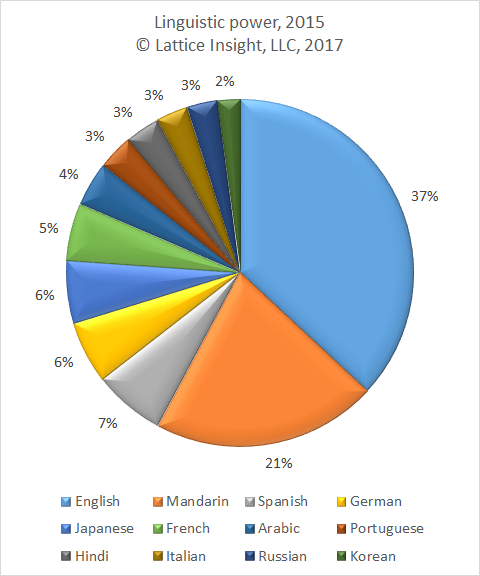We compare the power of languages across the world economy. We collected data on the 50 countries with the largest GDP, as measured nominally (at current exchange rates) or by PPP (purchasing power parity, adjusting for prices). We also collected data on which languages are official in each country, and what fraction of the population speaks various languages. The power of each language was added up across the countries in the study, and we computed the geometric mean of GDP nominal, first language speakers; GDP PPP, first language speakers; GDP nominal, official language; GDP PPP, official language. The twelve highest ranking languages are depicted above, as a fraction of their total, not out of total world GDP.
The pie chart is a bit misleading; obviously there are many smaller languages with some share of world GDP. Nevertheless, the error is not large, because there are many countries not included in our study, which have official languages or native speakers included in the chart above. This is true especially for the languages that are official in the most countries: English (59), French (29), Arabic (27), and Spanish (21). For comparison, were the chart continued, Indonesian would rank slightly below Korean, and Dutch about half that level.
Chinese and Hindi are official languages in what are by far the two most populous nations on earth; nevertheless, they have little influence outside their home countries.
The linguistic concentration of economic power is impressive. English and Chinese account for more than half of world GDP. When we add the languages of the world's third and fourth largest economies, Japan and Germany, and the three other widespread languages listed above, we are looking at roughly 86% of world GDP, created by 7 languages.
The pie chart is a bit misleading; obviously there are many smaller languages with some share of world GDP. Nevertheless, the error is not large, because there are many countries not included in our study, which have official languages or native speakers included in the chart above. This is true especially for the languages that are official in the most countries: English (59), French (29), Arabic (27), and Spanish (21). For comparison, were the chart continued, Indonesian would rank slightly below Korean, and Dutch about half that level.
Chinese and Hindi are official languages in what are by far the two most populous nations on earth; nevertheless, they have little influence outside their home countries.
The linguistic concentration of economic power is impressive. English and Chinese account for more than half of world GDP. When we add the languages of the world's third and fourth largest economies, Japan and Germany, and the three other widespread languages listed above, we are looking at roughly 86% of world GDP, created by 7 languages.

 RSS Feed
RSS Feed